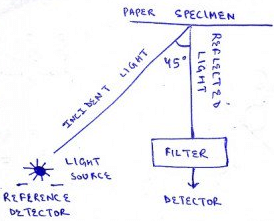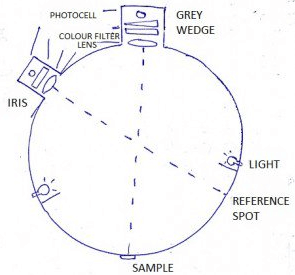This set of Pulp and Paper Multiple Choice Questions and Answers (MCQs) focuses on “Basic Optical Tests of Paper”.
1. ___________ is the measure of the hue or chroma of light reflected from the surface of paper.
a) Pigment
b) Colour
c) Opacity
d) Brightness
View Answer
Explanation: Colour is the measure of the hue or chroma of light reflected from the surface of paper. It cannot be easily put in numbers, and it is frequently expressed descriptively, as “red” or “blue”. Colour of paper can be expressed by a series of three numbers in the International scale (C.I.E.) system, x, y, and z.
2. ___________ is a measure of the “whiteness” of paper. These methods are not applied to coloured papers that are characterized with the tests. The ___________ is the % of diffuse reflected light from a thick pad of paper to visible light.
a) Pigment
b) Colour
c) Opacity
d) Brightness
View Answer
Explanation: Brightness is a measure of the “whiteness” of paper. These methods are not applicable to coloured papers that are characterized with the tests described above. Precisely, brightness is the % of diffuse reflected light from a thick pad of paper to visible light at a wavelength of 457 nm. This brightness is designated as R(infinity).
3. What is the name of the instrument?

a) H.G. Brightness
b) L.K. Brightness
c) M.K.L. Brightness
d) P.L. Brightness
View Answer
Explanation: In the G.E. brightness, the light is illuminated on the paper at a 45 degree angle and the reflected light at 0 degree’s measured. If an ultraviolet source’s utilized, the effect of fluorescent dyes, the optical brighteners, can also be measured.
4. What is the name of the instrument?

a) H.G. Brightness
b) Elrepho test
c) Opacity test
d) Colour test
View Answer
Explanation: In the Elrepho test , light source diffuse and the reflected light is measured at right angle from the surface of the paper. The diffuse light source’s a sphere coated with TiO2 from which light from 2 light bulbs reflects.
5. ___________ is the ability of paper to hide or mask a colour or object in back of the sheet. A high _________ in printed paper allows us to read the front side of the page without being distracted by print images upon the back side.
a) Brightness
b) Colour
c) Opacity
d) Gloss
View Answer
Explanation: Opacity is the ability of paper to hide a colour or object in back of the sheet. A high opacity in printed paper allows us to read the front side of the page without being distracted by print images upon the back side.
6. What is the name of the hidden part?
__________= (R0) / (R∞) x 100%
a) TAPPI opacity
b) Printing opacity
c) Solid opacity
d) Chroma opacity
View Answer
Explanation: Printing opacity is the ability of paper to mask a colour or object in back of the sheet. A high opacity in printed paper allows one to read the front side of the page.
7. What is the name of the hidden part?
__________= (R0) / (R0.89) x 100%
a) T.A.P.P.I. opacity
b) Solid opacity
c) Chroma opacity
d) Printing opacity
View Answer
Explanation: T.A.P.P.I opacity is the ability of paper to hide or mask a colour or object in back of the sheet. A high opacity in printed paper allows one to read the front side.
8. ___________ is a measure of the sheen or polish of paper.
a) Opacity
b) Brightness
c) Colour
d) Gloss
View Answer
Explanation: Gloss is a measure of the sheen or polish of paper. It’s measured by illuminating the paper at a very low angle and measuring the reflectance at a similar low angle.
9. __________ pulps are of especially high opacity. Fillers tend to have high indices of refraction and provide interfaces for light scattering as well. The very high index of refraction of Ti2 allows thin papers to have high opacity as in the case of bible papers.
a) Rosewood pulps
b) Groundwood pulps
c) Roughwood pulps
d) Lignin-free wood pupls
View Answer
Explanation: Stone groundwood pulps are of especially high opacity. Fillers tend to have high indices of refraction and provide interfaces for light scattering as well. The very high index of refraction of Ti2allows thin papers to have high opacity as in the case of bible papers.
10. Putting a wooden stick in clear water at an angle; the stick appears to be bend at the water-air interface. What is the property we are talking about here?
a) Gloss
b) Brightness
c) Opacity
d) Illuminating
View Answer
Explanation: The classic example’s putting a wooden stick in clear water at an angle; the stick appears to bend at the water-air interface. Rough, non-flat surfaces help scatter the light in all different direction.
Sanfoundry Global Education & Learning Series – Pulp and Paper.
To practice all areas of Pulp and Paper, here is complete set of 1000+ Multiple Choice Questions and Answers.
If you find a mistake in question / option / answer, kindly take a screenshot and email to [email protected]
- Practice Chemical Engineering MCQs
- Check Chemical Engineering Books
- Apply for Chemical Engineering Internship
